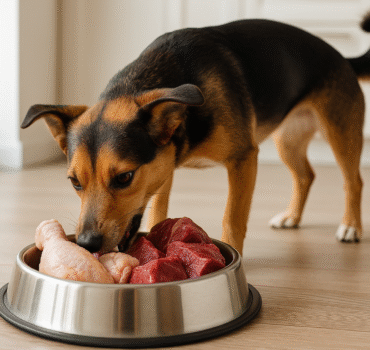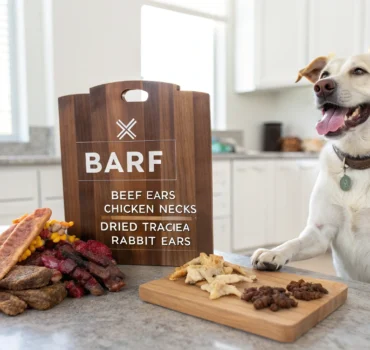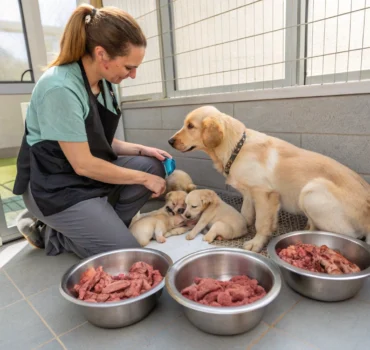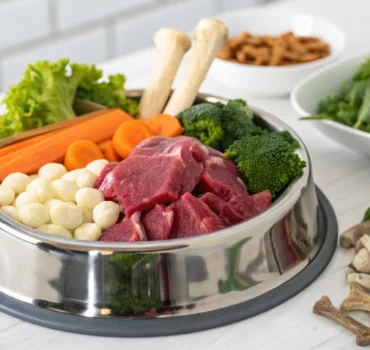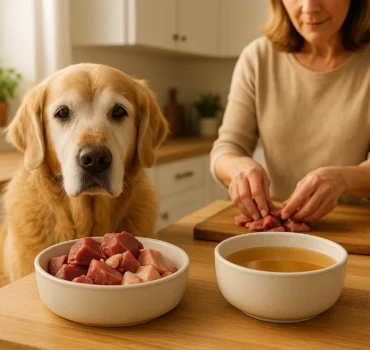Building Strong Foundations from 8 Weeks to Adulthood
Starting your puppy on a BARF (Biologically Appropriate Raw Food) diet is one of the best investments you can make in their long term health. While many puppy owners default to commercial kibble, raw feeding offers superior nutrition during these crucial developmental months when your puppy’s body and immune system are rapidly growing.
Puppies have different nutritional needs than adult dogs, requiring more protein, fat, and calories to support their explosive growth. A properly planned BARF diet provides these nutrients in their most natural, bioavailable form, setting the foundation for a lifetime of optimal health.
Why Start Puppies on Raw Food?
Puppies are naturally designed to thrive on raw food. In the wild, wolf pups begin eating regurgitated raw meat from their parents at just a few weeks old. Your domestic puppy has the same digestive capabilities and nutritional needs.
Superior nutrient absorption happens with raw food because nutrients are in their natural form. Growing puppies need maximum nutrition from every meal, and raw food delivers this more effectively than processed alternatives.
Stronger immune system development occurs when puppies eat species appropriate diets. The natural probiotics and enzymes in raw food support healthy gut bacteria, which forms the foundation of immune function.
Better dental development results from chewing appropriate raw bones. Puppies who start on raw diets typically develop stronger jaws and cleaner teeth that last throughout their lives.
Optimal growth rates are easier to maintain with raw feeding. You can adjust portions and fat content precisely to keep your puppy growing at the ideal pace for their breed.
When to Start Raw Feeding
Most puppies can begin transitioning to raw food around 8 weeks of age, though some may start earlier if they’re showing interest in solid food and have been weaned from their mother.
8 to 12 weeks is the ideal window to begin introducing raw food. Puppies this age are naturally curious about new foods and adapt quickly to dietary changes.
Gradual transition works best even for young puppies. Start by replacing one meal per day with raw food, then gradually increase over 7 to 10 days until all meals are raw.
Monitor closely during the transition period. Puppies should maintain steady weight gain and normal energy levels throughout the switch.
If you’re adopting an older puppy who has been eating kibble, the same transition principles apply, though it may take slightly longer for their digestive system to adjust.
Nutritional Requirements for Growing Puppies
Puppies need significantly more nutrition per pound of body weight than adult dogs. Understanding these requirements helps ensure your raw fed puppy gets everything they need for proper development.
Protein requirements for puppies range from 22% to 32% of their diet, depending on breed size and growth rate. Large breed puppies need slightly less protein percentage to prevent too rapid growth, while small breeds can handle higher protein levels.
Fat content should be 8% to 15% for most puppies, providing essential fatty acids for brain development and energy for growth. Fat also makes food more palatable for picky puppy eaters.
Calcium and phosphorus must be properly balanced for bone development. The ideal ratio is approximately 1.2:1 calcium to phosphorus. Raw meaty bones naturally provide this balance when fed appropriately.
Calories vary dramatically by breed and individual puppy. Small breed puppies may need 50 calories per pound of body weight, while large breed puppies might need only 30 calories per pound to maintain proper growth rates.
BARF Diet Components for Puppies
A balanced BARF diet for puppies includes the same basic components as adult diets, but in different proportions to support growth:
Muscle meat should comprise 70% to 80% of the diet. Choose lean meats like chicken breast, turkey, or lean beef. Fattier cuts can be included but should be balanced with leaner options.
Raw meaty bones make up 10% to 15% of the diet and provide calcium, phosphorus, and dental benefits. Chicken necks, wings, and backs work well for most puppies. Always supervise bone consumption.
Organ meat should be 5% to 10% of the diet, with liver being the most important. Organ meat is incredibly nutrient dense and supports rapid puppy development.
Vegetables and fruits can comprise 5% to 10% of the diet, providing vitamins, minerals, and fiber. Puree vegetables for better digestibility in young puppies.
Age Specific Feeding Guidelines
Puppy feeding requirements change as they grow, requiring adjustments to meal frequency and portion sizes:
8 to 12 Weeks Old
Feed 4 times daily with small, frequent meals to support rapid growth and prevent hypoglycemia in small breeds.
Portion size should be approximately 6% to 8% of current body weight daily, divided among all meals.
Softer textures work better for very young puppies. Ground raw meat mixed with small, soft bones helps them adjust to the new diet.
3 to 6 Months Old
Reduce to 3 meals daily as puppies can handle larger meals and their stomachs grow.
Portion size can decrease slightly to 4% to 6% of body weight as growth rate begins to slow.
Introduce variety by offering different protein sources and slightly larger bone pieces as teeth and jaws strengthen.
6 to 12 Months Old
Feed twice daily like adult dogs, though some large breed puppies may benefit from continued three meal schedules.
Portion size continues decreasing to 3% to 4% of body weight as puppies approach adult size.
Adult sized bones can be introduced gradually as puppies develop stronger jaws and better chewing skills.
Choosing Appropriate Proteins
Protein variety is important for puppies, but introduction should be gradual to identify any sensitivities early:
Chicken is an excellent starter protein for most puppies. It’s mild, easily digestible, and readily available. Chicken also provides good bone options for young dogs.
Turkey offers similar benefits to chicken with slightly different nutritional profiles. Many puppies tolerate turkey well as a second protein.
Beef can be introduced after chicken and turkey are well established. Choose leaner cuts initially, adding fattier options as puppies grow.
Fish provides essential omega fatty acids for brain development. Introduce fish gradually, starting with milder varieties like cod or salmon.
Novel proteins like rabbit, venison, or duck can be saved for later introduction, keeping them available if food sensitivities develop.
Bone Safety for Puppies
Raw bones are crucial for puppy development, but safety is paramount:
Size appropriately for your puppy’s current size, not their adult size. Bones should be large enough that puppies cannot swallow them whole.
Supervise consumption especially with new puppies who are learning to handle bones properly.
Start with softer bones like chicken necks or wings, progressing to harder bones as puppies develop stronger jaws.
Remove small pieces that could become choking hazards as bones are consumed.
Never cook bones as this makes them brittle and dangerous.
Common Puppy Raw Feeding Mistakes
Avoiding these common errors helps ensure your puppy thrives on their raw diet:
Overfeeding is easy with cute, begging puppies, but excess weight puts stress on developing joints and bones.
Insufficient variety can lead to nutritional imbalances. Rotate proteins and include all diet components regularly.
Too much too fast during diet transitions can cause digestive upset. Take time with changes, especially in young puppies.
Ignoring individual needs means missing signs that your specific puppy needs adjustments to the standard feeding guidelines.
Skipping veterinary monitoring during rapid growth phases can allow problems to develop unnoticed.
Monitoring Puppy Development
Regular monitoring ensures your raw fed puppy is developing properly:
Weekly weigh ins help track appropriate growth rates. Puppies should gain weight steadily but not excessively.
Body condition scoring is more important than absolute weight. You should be able to feel ribs easily but not see them prominently.
Energy levels should remain high and consistent. Lethargic puppies may need dietary adjustments or veterinary attention.
Stool quality indicates digestive health. Raw fed puppies typically produce smaller, firmer stools than kibble fed puppies.
Coat condition reflects overall nutrition. Healthy puppies have soft, shiny coats without excessive shedding or dullness.
Socialization and Raw Feeding
Raw feeding can actually support puppy socialization efforts:
Confident eating habits develop when puppies enjoy their meals and feel satisfied with their nutrition.
Calmer behavior often results from stable blood sugar levels that raw diets provide, compared to the spikes and crashes from high carbohydrate kibble.
Better focus during training sessions can occur when puppies aren’t dealing with digestive discomfort or food related sensitivities.
Positive food associations form when meal times are enjoyable and satisfying experiences.
Transitioning to Adult Portions
The transition from puppy to adult feeding happens gradually:
Large breeds typically transition between 12 to 18 months as their growth plates close and growth slows significantly.
Small breeds may reach adult feeding requirements by 8 to 12 months since they mature more quickly.
Individual variation means some dogs need longer puppy feeding schedules while others are ready for adult portions earlier.
Gradual reduction in daily food percentage should happen over several weeks rather than abruptly.
Long Term Benefits of Starting Early
Puppies who begin life on raw diets often show advantages throughout their lives:
Fewer allergies develop in dogs who start with species appropriate diets and avoid common kibble allergens during crucial development periods.
Better dental health continues into adulthood when puppies learn to chew bones properly from an early age.
Stronger immune systems result from optimal nutrition during the critical development window.
Improved longevity may result from the superior nutrition and reduced inflammatory load of raw diets throughout life.
Working with Veterinarians
Finding veterinary support for raw feeding puppies is important:
Seek knowledgeable vets who understand raw feeding or are at least open to learning about it.
Regular check ups are especially important during rapid growth phases to ensure proper development.
Blood work can verify that nutritional needs are being met, particularly for calcium, phosphorus, and protein levels.
Growth monitoring by professionals helps catch any issues early when they’re most easily corrected.
Conclusion
Starting your puppy on a BARF diet provides the strongest possible foundation for lifelong health. While it requires more planning and attention than opening a bag of kibble, the benefits of species appropriate nutrition during crucial development months are immeasurable.
Puppies who grow up eating raw food typically develop into healthier, more robust adults with fewer health problems throughout their lives. The investment in proper nutrition during puppyhood pays dividends for years to come.
Remember that every puppy is unique, and what works perfectly for one may need adjustments for another. Stay observant, be willing to make changes as needed, and enjoy watching your puppy thrive on the diet nature intended.
Ready to give your puppy the best start in life? Explore our puppy appropriate raw food options and start building strong foundations today.
Frequently Asked Questions
Is raw food safe for very young puppies? Yes, puppies can safely eat raw food starting around 8 weeks old. Their digestive systems are naturally designed to handle raw meat and bones.
How much should I feed my raw fed puppy? Start with 6% to 8% of current body weight daily for young puppies, decreasing to 3% to 4% as they approach adult size. Adjust based on individual growth rates.
Can I mix raw food with puppy kibble? It’s better to feed raw and kibble at separate meals if you must combine them, as they digest at different rates. However, full raw feeding provides the most benefits.
What if my puppy doesn’t like raw food initially? Some puppies need time to adjust. Try different proteins, slightly warm the food, or mix in a small amount of bone broth to increase palatability.
How do I know if my puppy is getting proper nutrition on raw food? Monitor growth rate, energy levels, coat condition, and stool quality. Regular veterinary check ups can confirm proper development and nutritional adequacy.

